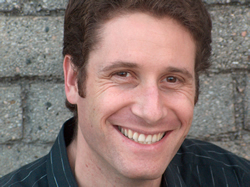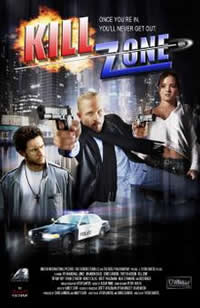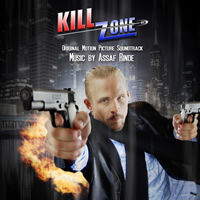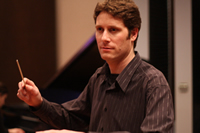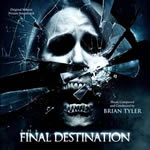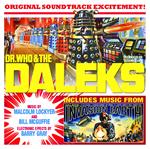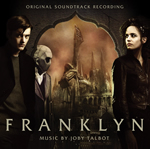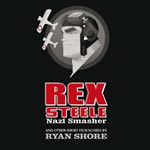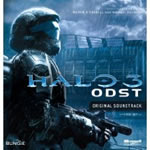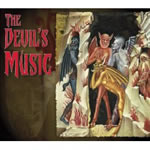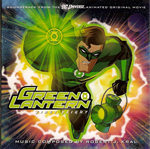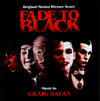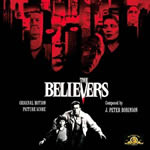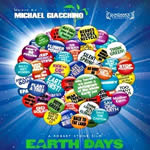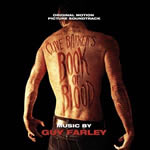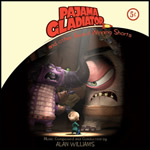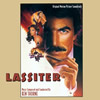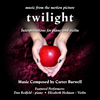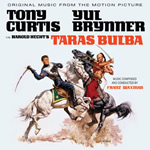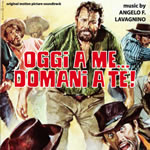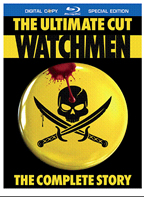 |
Soundtrax: Episode 2009-11
September 28th, 2009By Randall D. Larson
Asaaf Rinde Music in the Kill Zone: A Conversation with Assaf Rinde
Assaf Rinde has scored over twenty films and also worked as a contributor (score programmer or mixer) to such films as GHOST RIDER and SPIDER-MAN 3 with composer Christopher Young and the TV series SUPERNATURAL with composer Christopher Lennertz and LOST with composer Michael Giacchino. Assaf Rinde's musical studies followed a traditional and highly rigorous path starting in his native Israel and finishing at the University of Southern California. Along the way he worked with virtually all of the most prestigious musical organizations in Israel and many in Europe as well, including a key collaborative role in Isaac Steiner's opera The Picture of Dorian Gray in Prague in 2000. Rinde's concert works have been performed worldwide.
I discovered Assaf's score to KILL ZONE score recently and was blown away by it – what a marvelously textured, nuanced, and heart-felt melodic work. An opportunity to interview Assaf a couple of months ago was eagerly accepted and I am pleased to provide this remarkable composer’s perspectives as a newcomer to film scoring.
Q: How did you get involved in film music, and what did you learn from your first musical experiences in cinema?
Assaf Rinde: My involvement in film music developed because of my deep love for music, film, and the combination of both of them together. For many years I was already involved with music making before I started writing for movies, but from the moment I began, I could never really turn back. I started playing the piano when I was three years old and composed my first real composition when I was eleven, but it was only later on when I noticed for the first time the power of good film music. I think it was movies like Back to the Future and ET that really got my attention in terms of the way the music works to picture. Lots of composers and musicians are waiting for the right moment when all the stars are aligned and the muses are playing the right role so they can experience one moment of inspiration. For me the inspiration was there on the screen, and many times I was finding myself controlling the inspiration by just hitting the play button of the video footage and the music would radiate naturally into that zone. To me, there is nothing that can really replace this magical combination of strong images accompanied by the right music.
Q: Among your earliest scores were documentaries like The Players and Tokyo Nights. How did you try to musically enhance the nonfiction elements of these films – as opposed to more dramatic, fiction films? Did you find the musical structure or approach different?
Assaf Rinde: I think that filmmaking is filmmaking no matter what, and working on these movies was a great filmmaking experience for me. I think that the music component in documentaries is sometimes harder to create since there is no real acting on the screen. But the drama can be emphasized with the music and editing. In terms of musical decisions, the music was definitely affected by the non-fictional parts of these movies, but in some cases I had to take it to the next level in order to create a little more of the magic that was already there.
On The Players, the story already had so much magic in it. It is about a group of new immigrants from Russia who live in Israel and meet once a week to engage in role-playing games about kings, queens, dragons, magicians, witches, and mystics. The movie was about their normal lives and their separate lives in the game. The music was mostly consistent with their daily lives but when they were immersed into the actual game, the music took on the role of what you’d hear in a Middle Ages fantasy movie.
Tokyo Nights is a movie about a group of women who decide to travel to Tokyo and try to make lots of money being “Hosts” in some clubs/bars in Tokyo, in order to welcome men into those places and be “kind of a date” for one evening. With the music, I had to play on the “modern Tokyo” feel but I also had to play on the diverse cultural background and emotional crises that emerged as a result of their circumstances. It was an interesting exercise in maintaining balance in terms of how to not generate something that really is not present on the screen but at the same time give the movie enough drama to maintain the continued interest (musically) for the viewer.
Q: You composed the music for a film called The Golem of Prague, presumably a version of the classic Jewish legend. What was this project about and how did you approach its music?
Assaf Rinde: The Golem Of Prague is a short animated movie about the creation of the Golem by the legendary Maharal (a famous rabbi and philosopher from the 14th century). This story has a bit of a Harry Potter sensibility to it but in a very Jewish way, so I was trying to find the right balance musically between the magic of creation, the Jewish tradition and other elements, which can also symbolize the creation of Adam and Eve. At the same time, I had to hint on the danger of the Maharal acting like God when he is only a human being. It was lots of fun to do for so many reasons but also because it was my very first animation project.
Q: You have scored a number of shorts films. How would you contrast the dramatic and aesthetic musical approach and technique between scoring a short film and a full length feature?
Assaf Rinde: Each one of these projects was very different from the others. My process is usually pretty much the same except for the “spotting” process. When working on a feature I insist on mapping the entire movie beginning to end before I compose the first cue. Then, I start developing the themes and right after the director approves them, I go into the actual writing process. Working on shorts is a bit different because there is less music and, in some cases, it is literally wall-to-wall from the start, so I usually skip the spotting part and compose the cues chronologically straight to picture. Sometimes it ends up being a single long cue that covers the entire length of the movie from the very beginning to the very end.
Another challenge in working on a short is the limited time frame for thematic statements. When you work on a feature, you have 90 minutes or more to state your themes more than once so they can be identified with the movie and become familiar to the audience. When I work on a short, I always try to have a very strong musical signature and because of this small time frame for thematic statements, I usually decide on not more than one strong theme for a project. This way, the score can feel much more organic and the music can help the experience of telling such a story in a very short time. In some cases, like Mirror, the director was wishing for a longer time frame for telling the story so he tried to create a “short length feature film” and the music had to support that approach. The film has an opening montage/chase that follows the main credits and I had to write a traditional Main Title cue for that project even though it was only a short.
Q: Nailed was one of your first feature film scores. What were your initial inclinations as to the type of music it needed and how did you develop those initial ideas into what became the complete score?
Assaf Rinde: Nailed has two distinct parts. The first one is pure action and the second is pure horror. Like the film, I gravitated towards those two directions. My first take on the music was more twisted, melodic thriller music, but Adrian O’Connell (the director) was asking for more of an abstract approach for the horror elements. For the action, I tried to give the sense that something very wrong was about to happen and I played with this approach all the way till the two main characters were escaping into the haunted house. Then from that moment on I composed very clustery/abstract/avant-garde type music, which sometimes gets very violent and very dark as the movie progresses. I think the peak point of the entire score is the murder flashback scene. It is very brutal on screen and the music gets really scary and very loud.
Q: What kind of instrumentation/orchestration opportunities did you have with Nailed?
Assaf Rinde: The right approach for Nailed was to go with a synth score from beginning to end. There was no point in hiring an 80 or even a 50-piece orchestra for the task because of this abstract approach I talked about earlier. I used lots of sampled orchestral elements and phrases for some of the key moments but in so many places in the score I tried to create the feeling of unidentified musical elements, so you can’t tell what instrument is really playing.
Q: I found Kill Zone to be an especially evocative and persuasive score, very rich in melody and in instrumental flavoring. How did you get involved with this film and what elements of the story or the visuals did you decide to build the score around?
Assaf Rinde: I responded to an ad for a composer who can write music for a modern Western movie. Sometime after that I got a reply from producer Michael Carr who I met to audition/interview me for the job. This meeting was so much fun and we were totally on the same page, so a few days later I had another meeting with the director of the movie, Vitor Santos. I was so glad everything turned out the way it did and I started to score the movie not too long after that.
My main approach to the score was to create modern sounding Western music that has some elements from the Baroque period. The movie is a contemporary styled Western that takes place in a small town where many of the main triggers for the development of the story are the church and bible. When I created the music for Kill Zone I used all these elements together in order to deliver a new and very specific sound for this movie. The score has many musical elements that were inspired by the old Western movies scored by Ennio Morricone, but it has a different and more modern flavor to it. At the same time, the music for Kill Zone is not wall-to-wall western music. It also features lots of darker and more sentimental cues.
Q: How closely did you work with the director in spotting the music and establishing what kind of score this film needed?
Assaf Rinde: Vitor was involved on every single cue in this project. His input was very helpful and that took the entire process to the next level in terms of collaboration and creativity. Vitor came with the old Western approach and I was the one who pushed for the more modern sound in the score and I think the balance between the two extremes got us to where we ended up. I believe this musical blend contributed to a strong signature that was created from the collaboration.
Q: Your use of Iris Malkin’s voice is especially provocative in this score. While soprano voicings are more often being used as orchestral elements in film scores these days, your use of her voice seemed especially expressive and haunting. How would you describe your integration of her voice with the score’s thematic structure, its orchestration, and its relevance to the film’s subtexts?
Assaf Rinde: The vocal parts in Kill Zone were very important to the score in this movie’s context. I brought in Iris Malkin to support only those key moments where you just had to take it up a notch emotionally and I think that created some peak points in the score that no instrument could have established there. Most of these moments are moments of catharsis, moments of change where the characters are paying the price for their acts and growing from that. Some of these moments are also somewhat romantic and it seemed like the right way to go from day one.
In the European film market, the use of female voice is still very frequent and because the movie was so influenced by the old Spaghetti Westerns, it was appropriate to bring in some of this more European flavor into play. I must say that Iris was the perfect choice for that part not only because of her amazing musicality, but especially for her very unique and warm vocal timber, which gave it the spark it really needed. This score needed something between operatic and non-vibrato, non-operatic vocal techniques, who can rarely be found all together and on such a high level in one singer and Iris really took this part and captured it both musically and emotionally.
Q: You also used guitarist Israel Klich and trumpet player Sean Hennessy as distinctive elements of the Kill Zone score. What unique nuances did you want them to bring to this score and its overall sound?
Assaf Rinde: Israel Klich, who played the guitar parts, did a fantastic job and since there was so much guitar performance in the score, I had to come up with something that would make a big difference with this instrument. With the help of Israel, we have made the choice to use his very unique sounding flamenco guitar and I recorded and produced this guitar in a way that gave it a very warm, distinct sound. In some moments you can’t really tell if this is an acoustic/classic guitar or maybe even electric guitar and this trait gave the score its feel. Additionally, I decided to give the score some baroque elements from its harmony to instrumentation, so instruments like the Harpsichord, Church Organ and the guitar (replacing the Lute) were also part of that concept. In many of the westerns the guitars were electric but it didn’t feel right for Kill Zone.
The trumpet parts are introduced at key moments similar to the vocal performances, but with a much more specific feel to it. Sean Hennessy brought in his incredible collection of trumpets and when we recorded the score, we had the opportunity to experiment with different sounds and effects. That gave the score this edgy feel on those big moments, and Sean amazed me with his ability to perform every crazy idea I had for these cues. One more amazing performance was in “The Last Dance” where Sean played more of a film noir/jazz ballad cue, and the amount of warmth he brought to it made me appreciate his abilities even more.
Q: What was most challenging – and most rewarding – for you about scoring Kill Zone?
Assaf Rinde: Working with Vitor Santos on Kill Zone was a pure pleasure even though it was one of the more challenging projects I have worked on. There is very little dialog in this movie and the music had to really support some long sequences and montages that moves the story forward.
I think that the most rewarding part was seeing Vitor’s smile when I was done with composing and mixing the music. He was so happy and I just knew I did something right. There is nothing more rewarding than knowing that you did the right thing J
Q: You also worked closely with Christopher Young on programming his scores for Spider-Man 3 and Untraceable. When wearing this hat, how have you worked with the composer to achieve his vision for the score and its sound?
Assaf Rinde: When working on another composer’s music I always take myself out of the composer’s chair. It is very important to understand that it is not your show when you do that. I’ve established a great relationship with Christopher and we’ve been working together for the last few years and hope to continue this relationship. The last project I worked on for Christopher was producing his soundtrack album for The Uninvited. In a support capacity, I assist him in making sure all the details are right and everything is being delivered on time and on the highest level.
Q: You scored trailers for films like Starship Troopers 3 and Race to Witch Mountain. What are the unique challenges of providing the right dynamic for a trailer score, and is there ever a need to correlate what you are writing with the film’s actual score as it is being developed?
Assaf Rinde: Trailers and trailer music usually have a completely different energy and feel from the movie they are promoting. Very rarely is the actual score from the movie being used as the trailer score, but it does happen once in a while. Actually, on Kill Zone they were using my original score for the movie on the official trailer, but the music had to have that trailer quality in order to represent the right idea and feel. On Starship Troopers 3, the music was written after the trailer was already done and the music I wrote had nothing to do with the score for the actual movie. Music for trailers is usually not written to picture and in most cases like in Race To Witch Mountain the actual trailer was edited to my music. I think this approach is really great for trailers because the picture editing and the music are working on exactly the same pace (a bit like a music video) and it brings the overall experience to a much more powerful impact in no time, which is pretty much the time they have to seduce you with their upcoming new movie.
For more information on Rinde, have a look at his web site at: www.assafrinde.com
New Soundtrax in Review
Varese Sarabande has released Brian Tyler’s score for The Final Destination, the fourth entry in the franchise begun in 2000 by former X-Files writers James Wong and Glen Morgan. The first three films were scored by Shirley Walker, who gave the films a consistently palpable musical propulsion. But her unfortunate death in 2006 regrettably curtailed a continuation of her musical design in further sequels. After some consideration, director David R. Ellis, who had also helmed Final Destination 2 (2003), asked Brian Tyler to score the fourth outing. Tyler has supported this film’s action, sense of fantastique, and brutal, violent shocks with a potent mix of ambient atmospheres and progressive, driving propulsion, from the blistering rock and roll of the main theme to the omnipresent chills provided by somber, sustained string chords and relentless chase motifs. Tyler has incorporating Shirley Walker's main theme from the first three films, which gives the new score a proper sense of connection to the first three, while he also has derived a musical dynamic that both reflected the legacy of the series while providing something new to this excursion. Scenes like “The Raceway,” which is where the initial tragedy occurs in which our film’s heroes escape, and spend the rest of the movie evading death when it comes calling to make up for missing then, is a slammingly percussive, a devastating rhythmic cacophony for destruction, followed by the gentle “Memorial” as those who did not escape death’s initial visitation are mourned. As things move from grief to suspense, anticipation to realization and terror, Tyler composes multiple layers of ambient sonorities and progressive riffs of percussion-led synth and orchestral pads that generate a fatalistic drive to the characters’ rush toward their inevitable final destiny, building the anticipation and intensifying the grisly payoffs that have become characteristic of this series, while also providing a gentle, breezy melody for the film’s gentler environment. Recognizing that horror scores, in particular among all species of film music, are by nature manipulative: intensifying emotions, anticipating events about to occur on screen, generating heightened excitement in the viewer, Tyler has purposefully geared his music to operate subtly with finesse, or ferociously with propulsion, as the storyline and visual style dictates. His score for Final Destination is primarily a propulsive, driving headlong flight from death, but there are moments of sensitivity of grace in the process.
Silva Screen will make millions of Doctor Who fans happy with the first-ever soundtrack release of music from the big screen Doctor Who films ever made – Amicus’ 1965 release Dr. Who And The Daleks and 1966 Daleks Invasion Earth 2150 A.D., both of which were highlighted by a marvellous performance by Peter Cushing as everyone’s favorite Timelord, and by their music. Scored with a complete indifference towards the musical sound design of the TV series, which was launched in 1963 by the BBC, the music was composed by Malcolm Lockyer and Bill McGuffie, respectively, with sections enhanced by electronic sounds created by Barry Gray, famed for his work with Gerry Anderson. In addition to the full scores from both films, the album also includes contemporary single releases and a 20-page inlay booklet packed with memorabilia and detailed production notes. Lockyer’s music for Dr. Who And The Daleks (note that the film abbreviates it “Dr.” while the series has always spelled it out, Doctor Who) is tuneful and poppy, his Main Title introducing the grand music for the Daleks, a melodic kind of march for guitar/trumpet over pulsing winds, cantering string figures, and a xylophone/drums beat. More symphonic oriented material appears during the action moments, such as the furtive winds and xylophone raps over electric bass and harp when the time/space traveling T.A.R.D.I.S. lands on the planet Skaro. The Dalek Theme is later modified into a variation flavored for a John Barryesque trumpet as the Doctor and his family slip out of the Dalek’s habitat, and a gentle flute-driven reading. Action cues like “The Trap,” “Escape from the Cell,” “The Swamp,” and “The Thals Approach the City” are awash with thematic references and a likable orchestration of strings, bongos, xylophone, harpsichord, harp glisses, doomstriding timpanies, all subservient to the overarching Daleks’ theme. Lockyer’s End Title reprises a swaggering Barryesque coloration for electric guitar and strings. Bill McGuffie, whose jazz-infused score for 1968’s Corruption remains an outstanding example of jazz as dramatic film music, provided a marvelous score for Amicus’ second and final Doctor Who feature, poor box office damning producer Milton Subotsky’s hopes for continuing features once a year. For Daleks Invasion Earth 2150 A.D., McGuffie took Lockyer’s lead and crafted a pleasant, pop and jazz score, with a main theme for strings over a festive bongo beat, which both fit the style of the first film as well as the tone of the TV series. The composer’s predilection for piano is well serves in the Daleks score, which contains some exceptional piano writing and performance (most likely it is Bill who plays the piano on the score). Right after the Main Titles, McGuffie provides a marvelous and celebrated composition heard during the opening robbery scene on earth, present day (“Smash and Grab”). A compelling interpretation of Bach’s Toccata & Fugue in D Major is played on piano, over which the main theme shortly begins from a delicate but swinging clarinet over brushed drums; the combination of the theme with the rhythmic piano playing on beneath it, is very compelling and gives the film a unique opening tonality. The cue is presented with the robbery sound effects but is reprised without them on a later track, where it morphs into the End Titles, and is a thoroughly engaging composition. Once the T.A.R.D.I.S. arrives in 2150 A.D., and confronts an in-progress colonization by the hated Daleks, McGuffie provides a bold, martial version of the main theme, signifying the militaristic presence of the Daleks here. A recurring action motif consists of fast-fingered piano with a jazzy saxophone melody (elsewhere raucous trumpet figures), which provides a significant energy to the prisoner escapes and Dalek fights. It’s an unusual approach for science fiction but it works and fits the film’s overall style very well. Two bonus tracks provide a touch of Barry Gray’s electronic sound effects.
Mischa Spolianski (1898-1985) scored some four-and-a-half dozen film scores between 1930 and 1973, but very little of it has been remembered on LP or CD. Naxos, in their laudable and ongoing series of “Film Music of…” albums, finally gives Spolianski a sense of justice with this fine compilation of some of his best musical scores, beautifully performed by the BBC Concert Orchestra under the baton of Ramon Gamba. Opening with an adventurous suite from North West Frontier (1959, an adventure drama in British India) we have a rousing and articulate measure of action scoring bolstered by a noble trumpet motif reflecting the military protagonists. “Attack on the Train” is an especially provocative cue, aggressive progressions of winds driven by strings, with tremolo strings, aggressive, footsteps brass chords and rolling snare and crashing timps as the cue plays out. The music for the 1936 film of H. G. Wells’ The Man Who Could Work Miracles evokes the title characters’ magical powers with a fantasia for delicate, piping woodwinds counterpointed against the soft lowness of a quiet bassoon. In the end, the miracle worker conjures up a grand palace and parades himself throughout, accompanied by a vividly ostentatious orchestral march, until he realizes all is not right when he nearly brings about the end of the world, at which point he reluctantly relinquishes both his megalomania and miracle powers. A rich, piano concerto from Wanted for Murder (1946) is bridged by a compelling mysterioso rendition for winds and strings, a very lovely cue. Spoliansky’s marvelous score from The Ghost Goes West (1935) is perhaps the albums’ highlight, with four short cues of about 2 minutes each. The film, one of those gentle and enjoyable ghost fantasies of the 30s and 40s, is about an American who buys a Scottish castle and transports it to the US – along with its resident ghost. Spoliansky’s main theme instantly evokes the film’s original Scottish environment with an orchestral interpretation of a Scottish tune for strings embellished by piping woodwinds. The ghost is evoked with quiet phrases from strings and winds, capturing the same Scottish textures from his Prelude and stirring them into a hushes mysterioso that suggests, in its slow cadence, the weary pacing of the castlebound ghost. The ghost music is far from frightening, but instead suggests the humanity that once existed within that translucent frame, the lonely mind lingering in that ethereal cranium. A soft love theme for violin is also provided, and the suite provides examples of each of these thematic elements. Also of note is a rousing suite of music from the 1937 King Solomon’s Mines, an exotic, orchestrally flavored adventure composition. Two of the cues consist of folk tunes sung by characters (“Wagon Song” and “Mountain Song”). Overall this is a fine album of golden age film music and an excellent gallery of the work of one of Hollywood’s more underrated composers.
Silva Screen is releasing Joby Talbot’s quirky and classical soundtrack to Gerald McMorrow’s 2008 scifi thriller, Franklyn. Set simultaneously in present day London and the futuristic Meanwhile City, a monolithic fantasy metropolis governed by religious fervor, the story tells of a quartet of people each searching for meaning amidst loss. Talbot, noted for scoring TV’s The League Of Gentlemen(1999-2002), The Hitchhiker’s Guide To The Galaxy (2005), The League Of Gentlemen’s Apocalypse (2005) and the comedy Son Of Rambow (2007), has provided a mostly reflective score punctuated by a few action moments. Hinted at in the opening cue, stated eloquently as we first encounter Meanwhile City, and developed to its fullest in the End Credits is a passionate composition for piano and orchestra than summarizes the characters’ poignant drive. In between, the music is mostly quiet and ambient, floating across the futuristic landscape evoking the introspection of the characters, playing their thoughts and feelings much more than the environments of the film itself. Talbot occasionally lets a phrase or a short pattern of his opening theme resonate to the surface, but it’s most often elusive, as is peace and comfort for the film’s characters. It’s an often soothing, if occasionally elusive, score.
MovieScore Media has released a fourth soundtrack from composer Ryan Shore, whose scores for Jack Brooks: Monster Slayer, ShadowsandNumbhave already been released by the label. Because Shore had done a lot of short films, MSM has collected ten of them and released them together in Rex Steele: Nazi Smasher And Other Short Film Scores, now available on CD and Internet download. The compilation is really a two-fold value – on one hand we get to see just what kind of amazing music can be composed for short films (almost none of which ever get released on soundtracks since they are so short), and on the other hand it’s an excellent gallery of the variety of music found in Shore’s catalog. The title film, Rex Steele: Nazi Smasher (2004) is an animated World War II drama, with a stirring and heroic score done in a compelling 1940s symphonic style – very provocative and stylish. Shadowplay (2002) is also animated, about the aftermath of the 1945 bombing of Hiroshima; the score is subtly reflective, with lots of solo violin and flutes, stark and haunting in its sound design. A Letter from the Western Front (1999), is a reading of a letter from the battlefield of World War II, dramatized in animation, beautifully and emotively scored for winds and strings, very poignant and affecting. Dark and quirky, Cadaverous (2000) combines a medical student’s latent necrophilia with his need to pass his medical exams; the score is delightfully dark, malevolent, and of course enticingly alluring. Prom Night (2003) is a cute live-action comedy about a prom night date – Shore’s music, performed by a string quartet, is brimming with anticipation and barely contained restraint. The breathtakingly Williams-esqueArticles of War (2009, which recently opened at the Montreal Film Festival) is from the same director as A Letter from the Western Front (Daniel M. Kanemoto) and is an animated dramatization about a letter from the front lines, this time from a young American pilot fighting in 1944 who writes what may be the final letter of his life, bearing his soul to the man who inspired him to enlist... his father, a stoic WWI vet. Shore’s music is masterful, evoking both the excitement and fear or aerial combat, while musically unraveling the feelings that lay at the heart of the young man’s honest epistle. Each of these scores, which are represented by three to nine tracks (and there’s also a quartet of single cues from four additional short film scores) is musically distinctive and each is entirely captivating. Built around orchestral melody (possibly sampled, but if so very nicely done), Shore provides miniature epic scores for each of these miniature feature films, evoking in five or ten or twenty minutes the same kind of scope and musical excitement and eloquence one would find in a much larger and longer work. Kudos to Ryan for his musical chops on these scores, and to MSM for preserving them in such fine form.
Sumthing Else Music Works has released the original musical score from the video game Halo 3: ODST composed by Martin O'Donnell and Michael Salvatori. The 2-disc set is available on CD and also for digital download. The popular game series, in this outing gamers experience events leading up to the epic story told in Halo 3 through the eyes of an ODST (Orbital Drop Shock Trooper), as they search for clues leading to the whereabouts of their scattered squad and the motivations behind the Covenant's invasion of New Mombasa. Like much of game scores, at its best the music is highly cinematic, melodic, atmospheric, and dramatic, achieving a powerful orchestra sensibility (Seattle’s Northwest Sinfonia) embellished by vocal samples and provocative soloing, with occasional added riffing from electric guitar doubling the orchestral rhythm; at its least, the music is overly repetitive in its rhythms and riffing, needing to accompany hopefully long moments of point-winning gameplay. For the album, O’Donnell has arranged a dozen suites (over two discs) to match what the player would hear if he or she played straight through the game, eliminating the interactive musical tangents. The music is primarily a kind of rhythmic ambiance, punctuated by heavy drumming, some of which gets a bit tedious on the disc without their associative visual counterparts; but the overall thrust is one of persuasive instrumental textures and for the most part it works pretty well; on CD the score paints a dark picture of shadowy atmospheres and imminent danger. The saxophone riffing in the midst of “Asphalt and Ablution” provides a cool contrast to the orchestral rhythms and pounding percussion, and lends a bit of the film noir flavor that the game developers were seeking in the midst of their wargame; but the ongoing percussive and reverbed synth interaction of “The Office of Naval Intelligence” seems a bit overly redundant and lacking in progression, although the cue’s oppressive darkness does render it fairly spooky. The piano and orchestral interplay in the first half of “Bits and Pieces,” on the other hand, is very interesting and progressive, and is nicely reprised in the powerful “Finale.”
Naxos has released The Devil’s Music, a likable 2-cd classical collection of sinful symphonic music, from the orchestral rendition of Bach’s Toccata and Fugue in Minor through all manner of decidedly satanic sonorities and luciferian largo. Of course Saint-Saens’ Danse Macabre and both Liszt’s and Prokofiev’s Mephisto Waltz are present, along with Meynaud’s and Wagner’s and Schumann’s Faust, Stravinsky’s The Devil’s Dance, and Liszt’s Mephistopheles, but there are also some lesser known but equally diabolically dispassionate delicacies, such as Rodrigo’s The Devil’s Seguidillas, Vaughan Williams’ Satan’s Dance of Triumph, Ligeti’s L’Escalier du Diable, Bax’s The Devil That Tempted St. Anthony, and Schubert’s The Devil’s Pleasure Castle. The classical pieces included here (no performing orchestra or conductor is credited) are not only representative of a wide variety of significant composers but embody an intriguing array of dark and often horrific music, which will certainly appeal to horror music aficionados.
Speaking of which, John Ottman’s score for Orphan, released on CD by Varese Sarabande, is an attractive terror score. The film, from Jaume Collet-Serra, who directed the 2005 House Of Wax remake which Ottman also scored) is about a couple who, in the aftermath of losing their baby, adopt a 9-year-old girl, who of course winds up being the literal child from hell. Ottman’s music begins with a breezy rhythm and several keyboard and orchestra motifs as we get to know the husband and wife, and then the less-than-precocious Esther; eventually a shadow falls upon the music and its cheery face is beset by awkwardness, anticipation, and dissonance, as in the chilling “Destroying the Evidence,” where Ottman’s wildly aggressive violin figures and reflective piano fingering bursts into a diabolical yet controlled dissonance for cyclonic strings and whispering choral moans, the chanting of hopeless souls, capped a couple of times by a wickedly howling horn eruption. “Painting a Story/Esther Comes Home” is an evocative piano melody over lush, soft-focused synths, a delightful if ultimately deceptive cheery atmosphere. “The Cold Shoulder” is a potent bit of string-driven musical mayhem, as layers of percussive and reflective synths shoulder up against the violin patterns and drive them into especially spooky territories; segueing into the poignant piano melody at the end, the coldness giving way to the warmth of reassurance. This is a an especially nice horror score because it never devolves into effects or sound design, but retains its inherently musical sensibility, based on melody, which contrasts intriguingly against the spookier sonorities. There are a few songs bracketing the score tracks on the album, most of which are renditions of Billy Hill’s 1936 standard “The Glory of Love” – Jimmy Durante’s 1964 version, a snipped intoned by the film’s bad girl star, Isabelle Fuhrman, and a new version performed by folk songstress Krystie Warren along with an electronica ensemble, probably brought together for this occasion, called Orphanesta; plus a scratched/hip hop variant on Ottman’s main theme adapted by the composer along with Kristopher Gee, and Mark “Dog” Sayfritz.
Robert J. Kral, noted for his work on the Buffy spinoff TV series Angel, has returned to the DC Animated Universe after doing such a fine job on Superman: Doomsday (2007), with an equally heroic score for the home video feature Green Lantern: First Flight, an origin story for this popular character that was recently released on DVD. To be released shortly on CD by La-La Land Records, Kral’s score is a powerful, rhythmically heroic hybrid score that is quite likable. Rather than emphasizing the steely heroics or dark moods of Superman or Batman, Kral and the producers wanted to suggest more of a “sci-fi” attitude, since Hal Jordon’s Green Lantern power comes from space and much of the story concerns his ring-borne flights through space. Kral’s main theme is constructed around the idea of gathering power, as in the recharging of Green Lantern’s power ring, with measures of his theme building up until they can be fully expressed in heroic flight. In contrast with GL’s music, Kral provided a prickly, staccato type of theme for Sinestro, the rogue member of the Green Lantern Corps and the villain of the piece; his music is evocative of subtle but very capable menace. To Kral’s credit, he makes the most of familiar ground here, since this kind of score is an easy one to have fall into formula. And while the music meets expectations in its measured musical heroic pathos, Kral keeps it consistently interesting, evoking in the music compelling sonic textures and a powerful progression of his thematic material that drives the story – and the music itself. Even the obligatory percussive action cues (“Teleport Pursuit,” “Ring Against Ring”) are strikingly orchestrated and developed; it bristles with energy both restrained and released over and above its inherently repetitious riffing, powerfully bolstering the animated film’s emotive muscle. “Relinquishing the Ring” is a finely impassioned cue, emanating with volumes of emotional conflict in its layered tones of melody. This may not be the death of Superman, but it’s still an intensely powerful moment as Kral brings Jordon’s clashing feelings to eloquent and very real clarity. “Weaponers/Sinestro” seethes with reflective menace and synthesized textures; a vibrant French horn intones dolefully at 1:00 and heralds a bit of compelling chord progression amidst the electronic sound design, climaxing with a resolute intonation of failure as Sinestro cruelly triumphs; this feeling recurs in “The Corps Fall” and, just when it seems all has been lost, Kral breaks free with “Revival of the Green Lantern,” building up his main theme into a tremendously powerful reprisal, followed by inevitable punches of brass as GL sets things right. It’s fun super-hero music, affecting in its moments of quiet reflection, and cheer-inducing in its heroic rhythms as the good guys win the day.
Perseverance Records has released Craig Safan's score to Fade to Black (1980) as a limited (500 copies) composer’s promo CD. Safan was involved in all aspects of the production of the CD, and even asked me to write the notes for the album. The movie was a black comedy that focused on an obsessive movie fan named Eric Binford whose fixation descends into psychosis when he confronts a Marilyn Monroe look-alike whose unintentional rebuff launches him into homicidal mania. Impersonating a gallery of classic movie characters like Dracula, The Mummy, Hopalong Cassidy, and Norman Bates, Eric murders his oppressors in imitation of scenes from classic movies, finally targeting Marilyn herself. Instead of composing horrific music, Safan provided a melody-based score that emphasized the story’s twisted romance, centered on a single theme representative of Eric’s obsessive passion. The score combines a small, conventional orchestra emphasizing strings, piano, and percussion with electronic elements.
Also new from Perseverance, greatly extended from the original Varese soundtrack LP, is J. Peter Robinson’s horror score for The Believers, John Schlesinger’s 1987 thriller with Martin Sheen confronting a voodoo cult eager to sacrifice his son in modern day NYC. In his score, Robinson emphasized the story’s conflict between Catholicism and voodoo, the Catholic elements from orchestra and choir centering on Sheen’s character and a mysterious, eerily echoing theme played on a conch shell that represented the voodoo influences. The mixture of these elements, all of which except for the choir (London’s 40-voice Ambrosian singers) and percussionists (which Robinson says was a real percussion ensemble from New York that actually performed voodoo incantations) were performed on a Synclavier. The combination made for a strikingly nuanced and hauntingly atmospheric composition, especially for the End Titles, where the contrast between a children’s choir and the menacing, Santaria drumming suggests that ongoing challenge posted by the confrontation between innocence/goodness and the alluring influence of supernatural evil, with the threatening tonality of the conch shell arcing over it all. Perseverance’s package includes excellent liner notes by Rudy Koppl, who interviews both Robinson and Schlessinger about the score.
In a decided contrast between his propulsive and energetic feature film scores, Michael Giacchino has composed a subtle and softly atmospheric score for Earth Days, a new documentary film on the environmental movement whose score has been released to iTunes by Little Jacket Music. This is like Giacchino Light, or Giacchino Does Coulais – not quite what we’re used to from this composer, but a very likable and gentle score that lurks behind the narration and the cinema verite imagery of ecologists and activists in action. It’s a very pretty score in its minimalist rhythms and brief melodic flavorings. There is a bit of doom and gloom as the composer emphasizes the filmmaker’s cautionary warnings about the state of the environment, and in fact the score ends on an extremely powerful lamentation for the late, great planet earth which may well be out fate if, as the filmmakers’ surmise, things don’t change for the better.
The latest grisly horror tale from Clive Barker is Book of Blood, directed by horrormeister John Harrison (TV’s Dune, Tales from the Darkside) and a noted composer in his own right (Creepshow, Day of the Dead). The music for Book of Blood is from British composer Guy Farley (The Flock, Cashback, Land of the Blind), who has invested the score with – not the pervasive electronica of The Midnight Meat Train, Barker’s last cinematic adaptation – but a gentle and haunting mysterioso that evokes the scarifying awe of a house that exists at the intersection of so-called "highways" transporting dead souls across the afterlife. The music, released in a limited edition CD of 1500 copies from La-La Land Records, is therefore far more accessible on CD than the kind of superbly scary but difficult to listen to on its own sound-design style of horror scoring. Farley’s music is tonal, eloquently horrific, and mesmerizingly beautiful. A fan of Barker’s work since Hellraiser, he brought to the table a unique understanding of the author’s complex literary sensibility for the genre. Farley strove to write a melodic-based score using an unusual line-up of low strings (no violins, but basses, cellos, and violas with low brass, deep dark woodwinds, and an array of reflective and thudding percussion as well as ethnic instruments like the Armenian duduk and Eastern Europe’s cimbalom (a kind of dulcimer). “I also saw the film as a great place to use an instrument called a Monochord, which is the size and shape of a dining table with a belly of 50 resonating piano strings usually tunes in root and fifths, but open to some great detuning, giving a very weird and eerie effect,” as Farley states in his CD notes. All of this gives Book of Blood a fascinating and darkly tinged musical sensibility very appropriate to the brooding progeny of Barker’s imagination. Filigrees of furtive piano over hushed sustainments of synth evoke eerie suspense throughout the score; The provocative voice of Manickam Yogeswaren (Eyes Wide Shut) provided the Hebrew chanting that intensified a particularly disturbing sequence. There are moments of the cold sound design approach (the rushing sound waves of “Premonition,” the twisting string gatherings of “Descent,” the brutal sonic flurry of “Night Flies”) but the score’s overall sensibility is one of evaporating human warmth – wistful, emotive, but fleeting, intangible tendrils of human passion and sentiment drifting away into the ether, like the departing ectoplasm of a dying soul fleeing to the nether realms. Like Midnight Meat Train, Book of Blood culminates in a grim acceptance of one’s role in the new supernature of things as the protagonist realizes his place in the realm of traveling, tale-telling souls. The score, therefore, has been a journey, one of reluctance, apprehension, shock, horror, and ultimate acknowledgment and acquiescence. Farley has proven especially well tuned to this sensibility, and his score gives Barker’s breed of visceral, organic horror its human emotiveness. The result is an exquisitely flavored and hauntingly lovely horrific composition that just may write the book on horror scoring of the late 2000s.
Soundtrack NewsThe Emmy Awards happened the other week and the winners included John Williams, Joseph LoDuca, William Ross and Howard Goodall. John Williams won his first Emmy since 1972, when he got one for Jane Eyre; this year he won in the ‘Outstanding Original Main Title Theme Music’ for PBS’ Great Performances. Joseph LoDuca won the award for ‘Outstanding Music Composition For A Series (Original Dramatic Score)’ for ABC’s Legend of the Seeker (produced by LoDuca’s long-time friends Robert Tapert and Sam Raimi; this was LoDuca’s second Emmy Award; his first was for Xena: Warrior Princess in 2000).
William Ross, who won the 2007 Emmy for ‘Outstanding Music Direction’ for the Academy Awards, won this year’s award in the same category for Streisand: The Concert on CBS. British composer Howard Goodall won the Emmy for ‘Outstanding Music Composition For A Miniseries, Movie Or A Special (Original Dramatic Score)’ for the BBC/HBO Winston Churchill movie Into the Storm.
Congratulations to all.Varese Sarabande has announced its September 2009 Varese CD Club releases as: Children Of The Corn by Jonathan Elias (1,000 copies – just in time for his new score for the remake), A Walk In The Spring Rain by Elmer Bernstein (1,500 copies), Crime In The Streets by Franz Waxman (1,500 copies) and Escape From The Planet Of The Apes by Jerry Goldsmith (3,000 copies). www.varesesarabande.com
The new medical/emergency series Trauma debuts this week on NBC (Mondays, 9/8c). The series is the latest TV project to be scored by Bear (Battlestar Galactica) McCreary, and while fans of the Bear may find the lack of cylons, terminators, and other dangerous half humans a bit awkward, the composer isn’t completely turning his back on science fiction. “Trauma represents my long-overdue step out of the sci fi genre,” Bear wrote on his BG Blog. “But, don’t worry… with the rocket-pack-themed Dark Voidvideogame and BSG prequel series Caprica out in January, I’m in no danger of losing my sci fi cred just yet!... When I saw the first episode, I was hooked and knew it was a series I had to be involved in. Executive produced by Peter Berg, Trauma is an action series disguised as medical drama that focuses on EMTs in San Francisco. The show is shot and cut like a combat movie, where each sequence is infused with chaos and energy. Because the action takes place out in the field, it has a much more open and dangerous feeling than most medical dramas.” See: http://www.bearmccreary.com/blog/?p=2705
Speaking of short film scores (we were a few inches above in the Ryan Shore review), Alan Williams has released a collection of suites from award-winning short films – compiling scores from the Student Academy Award winner (2009) Pajama Gladiator and the Student Emmy winner The Lion And The Mouse as well as the festival award winners The Loch, The Juror, The Adventures Of Space Baby And Mental Man and The Teller’s Tale. www.alanwilliams.com
George S. Clinton has scored Mike Judge’s new comedy film, Extract, starring Jason Bateman, Mila Kunis, and Ben Affleck in a story about a flower-extract plant owner contending with various personal and professional problems, over which hilarity ensues. Clinton provided a quirky and playful score written for a small ensemble including guitar, mandolin, solo cello, pedal steel, and various percussion (including the sounds of people playing actual extract bottles). Incidentally, last June, Clinton, a Tennessee native, received the “Spirit of Tennessee Award” from the Tennessee Teacher’s Association for his dedication to promoting film music education (Clinton serves as an advisor at the Sundance Composers Lab). For more on George and his work, see: www.georgesclinton.com
Word has it also that Naxos will soon be releasing, for the first time, Aaron Copland’s music from the classic 1939 drama, Of Mice And Men.
Brian Tyler reports that a new fansite has been launched at http://web.me.com/cbarrywdw03/BrianTylerFanSite/Welcome.html. The site contains news and views and various reference material about Tyler’s music. Speaking of Tyler, movieScore magazine reports that he has been signed to score the remake of John Milius’ 1984 action thriller, Red Dawn (the original having been scored by Basil Poledouris and, incidentally, the subject of Intrada’s very first soundtrack release).
BSX Records has released Lassiter, featuring music composed and conducted by Ken Thorne for the 1984 action film written by David Taylor, directed by Roger Young and starring Tom Selleck, Lauren Hutton, Jane Seymour, Bob Hoskins, and Ed Lauter. As the film is a period piece, Thorne wrote a score drawn from elements of 1930s jazz music and also adapted popular tunes of the period to be used in the fabric of the score. A small orchestra made up of trumpet, clarinet, alto sax, trombone, tuba, banjo, drums, and piano would be used to perform the period elements of the score. Strings, French horns and extra percussion would augment the orchestra for some of the action scenes. Originally issued on LP at the time of the film’s release, BuySoundtrax Records presents the first appearance of Lassiter on compact disc, in a limited edition release of 1000 copies.
Kronos Records will issue Marco Werba’s score for Anita, a 2007 historical drama from Aurelio Grimaldi about Anita Garibaldi, the Brazilian wife and comrade-in-arms of Italian revolutionary Giuseppe Garibaldi. Their partnership epitomized the spirit of the 19th century's age of romanticism and revolutionary liberalism. www.kronosrecords.com
Clinton Shorter’s evocative score for the science fiction thriller, District 9, has been released on Sony CD and iTunes download.
Latest in its interpretations series, BuySoundtrax has released Twilight: Interpretations For Piano And Violin, based on music composed by Carter Burwell for the 2008 film. The composition has been structured into eight movements, covering the important thematic material composed for the film. This new recording has been produced and arranged by Dan Redfeld and features Elizabeth Hedman on violin and Redfeld on piano, with the approval of the composer. The digital EP is available for download on amazon and iTunes.
Kritzerland’s latest limited edition soundtrack is Franz Waxman’s brilliant music for the historical epic, Taras Bulba (1962). The film was a grand adventure yarn starring Yul Brynner and Tony Curtis, and directed by J. Lee Thompson, who'd just come off a huge smash hit with The Guns Of Navarone. From its rousing main title to its astonishing finale of nearly 12 minutes, Waxman's Taras Bulba is filled with one glorious cue after another, and features one of his most beautiful and incandescent melodies in “The Wishing Star’ – every time that theme makes an appearance in the score is utterly magical. The original LP release was a re-recording, as was the fashion in those days. The sound on that release was dry and shrill, and the sonics were further compromised because for an LP release, it was longer than usual. A CD was issued on Ryko back in 1998 (long out-of-print) – that CD was mastered from the original album masters and, while well produced, still had dry and shrill sound. For this brand-new edition, Kritzerland has uncovered the original three-track session master of the album takes – in other words, the first generation tapes. While still dry and shrill, the tapes were in perfect condition and the clarity was astonishing and Taras Bulba is sounding better than it ever has. Also found on the three-track master was the instrumental-only track to “The Wishing Star” and a female-only chorus version of the song (on the album it's male and female), both of which are included as bonus tracks. The great Bernard Herrmann called Taras Bulba "The score of a lifetime." And indeed it is - one of the greatest action/adventure scores ever written by one of the greatest film composers who ever lived. - www.kritzerland.com
Sincerely,Due for release on October 16th from All-Score Media: The Perfect Marriage (1968; Die vollkommene Ehe) and Every Night Of The Week (1969; Das Leben zu zweit - Sexualität in der Ehe) composed by Peter Thomas. The genre of sex education-movies boomed in Germany in the late 1960s, allowing the use of nudity justified by a (more or less) scientific plot. Director Franz Josef Gottlieb found success with several pictures in this vogue; for these two films, though, he adapted a 40-year old book by the Dutch gynecologist Theodoor Hendrik van de Velde to create two pseudo-scientific movies for his eager audience. Producer Horst Wendlandt asked his friend Peter Thomas (Space Patrol, Jerry Cotton) to compose original scores for both films. Until then they had worked together on numerous Edgar Wallace films and other blockbusters. Atypically for veteran sound pioneer Thomas his score to The Perfect Marriage is outrageously romantic, and the work holds an exceptional position in the composer’s oeuvre. Unfortunately this supreme accomplishment could be heard infrequently. Almost the complete opposite is the score to Every Night of the Week; here the composer is in his usual element again; contemporary jazz and beat arrangements, and unconventional use of the human voice dominate. Together both scores deliver a fascinating insight into the mastery of one of the most prominent composers of the German motion picture industry. www.allscore.de
New from Italy’s Digitmovies: Volume 14 in the series dedicated to the Italian peplum is the premiere release of the complete soundtrack by Angelo Francesco Lavagnino for the movie L’assedio di Siracusa (Archimede; aka Siege of Syracuse) directed in 1960 by Pietro Francisci and starring Rossano Brazzi. The story takes place at the time of the Punic wars when the conflict between the Roman Consul Claudio Marcello and the Syracusans is gradually getting stronger, a great man appears among the ranks of the Syracusan warriors: Archimedes. With his brilliance and inventiveness, and thanks to his burning mirrors, Archimedes destroys the Roman ships that have besieged Syracuse. Lavagnino’ s symphonic score perfectly combines the two worlds of Archimedes: the well documented historical facts about the confrontation, and his private life which was divided between the two beautiful women Diana and Clio. For this love affair Lavagnino has created a very sweet love theme which is one of the most beautiful of his career. Lavagnino alternates romantic themes with other heroic ones. The celebrated battle in which Archimedes’ “heat ray,” a method of reflecting and focusing sunset from multiple mirrors onto the wooden naval ships of Rome, destroys the enemy fleet is accompanied dramatic symphonic music for brass, percussions and strings. The CD is culled from the complete mono master tapes which have been preserved in very good conditions in the CAM archives since 1960.
Another Lavagnino score unearthed from the CAM vaults for new release is the Italian Western score for Oggi a me...domani a te! (1968; aka Today We Kill, Tomorrow We Die) directed by Tonino Cervi, scripted by Dario Argento and starring an International assembly of American actor Brett Halsey, Italian actor Bud Spencer, Austrian actor William Berger and Japanese actor Tatsuya Nakadai. The CD contains approximately 45 minutes of music restored from the original mono master tapes and it contains every single note recorded for the film. Five selections from this score have already appeared in a 1988 French compilation album. Lavagnino has written a really essential, minimalist style OST made up of suspended, mysterious and semi-psychedelic atmospheres performed by organ, vibe, guitar, brass and every type of percussion with a sparse but effective orchestra performance.
http://web.me.com/cbarrywdw03/BrianTylerFanSite/Welcome.html
DVD News
Watchmen: The Ultimate Cut arrives on Blu-ray and DVD on November 3 from Warner Home Video. From director Zack Snyder, this new and complete version of the action-packed blockbuster weaves Watchmen: Tales from the Black Freighter, the animated story-within-a-story into the Director’s Cut of the film in the same way the graphic novel did, creating a true ultimate version of the critically acclaimed story.
Available in a limited quantity of 70,000, Watchmen: The Ultimate Cut also features new commentary by Dave Gibbons and Zack Snyder along with almost 3 hours of extras, including Hollis Mason’s animated tell-all, Under the Hood. Also included is Watchmen: The Complete Motion Comic. Overseen by "Watchmen" illustrator Dave Gibbons and produced by Snyder, Watchmen: The Complete Motion Comic contains all 12 chapters of "Watchmen," the most celebrated graphic novel of all time, adding motion, voice and sound to the book's strikingly drawn panels, spanning everything from the mysterious demise of the Comedian to the crisscrossed destinies of loosely allied superheroes to their fateful impact on the world.
BLU_RAY and DVD ELEMENTS
- Watchmen: The Ultimate Cut film
- Audio Commentary with Zack Snyder and Dave Gibbons
- The Phenomenon: The Comic that Changed Comics (RT: 28:50) - Learn how the subversive, thematically complex, award winning comic that changed literature, inspired analytical debate, and won countless fans, was created.
- Real Super Heroes, Real Vigilantes (RT: 27:28) - Explores the fascination and psychology behind real-world vigilantes and where that behavior crosses over into actually donning the hood and behaving as superheroes.
- Mechanics: Technologies of a Fantastic World (RT: 16:46) - The creators of Watchmen had a great understanding of engineering and science, allowing for plausible mechanics in their characters tools and the world itself. This featurette will guide the viewer through the filmmakers’ process of turning these technologies into cinematic reality.
- Watchmen: Video Journals
- My Chemical Romance video Desolation Row (RT: 3:16)
- Under The Hood (RT: 36:00) - A retrospective look on the biography by Hollis Mason – the original Nite Owl – and the world of those who stood for hooded justice.
- Story Within A Story: The Books of Watchmen (RT: 26:00) - Weave through the nuanced layers of detail to see how a comic-within-a comic acts as parallel commentary to the acclaimed work of Literature, Watchmen.
- Digital Copy of the Theatrical Version
- Watchmen: The Complete Motion Comics
Games Music NewsInon Zur has composed the original score for Dragon Age™: Origins. Zur has been lauded for the emotional musical compositions he crafted for some of the most critically acclaimed video games including Baldur's Gate II: Throne of Bhaal, Crysis, Fallout 3 and Prince of Persia. The dramatic score for Dragon Age: Origins was performed live at A Night in Fantasia 2009 last Saturday night at the Sydney Entertainment Centre in Australia.
With a powerful original score recorded by the acclaimed Northwest Sinfonia Orchestra, Inon Zur's score to Dragon Age: Origins complements the game's epic, cinematic qualities, full of soaring melodies and lush, emotional orchestrations. The official soundtrack for Dragon Age: Origins will be available to purchase and download online from popular music sites when the game ships on November 3, 2009, while selected tracks from the soundtrack will be included in the Dragon Age: Origins Collector's Edition.
The full soundtrack is a collaboration between composer Inon Zur, vocalist Aubrey Ashburn and BioWare Audio Director Simon Pressey. The creative team will be presenting their work during a panel at the Hollywood Music in Media Interactive Conference on November 20-22, 2009, at the Renaissance Hollywood Hotel.
“From the moment you hear the Dragon Age: Origins theme to the lilting ballad, ‘I Am The One,’ at the end of the game, Inon’s score is hand in glove with the Dragon Age: Origins dark fantasy,” said Simon Pressey, the game’s Audio Director. “The Dragon Age: Origins score has an originality and passion to it that illuminates the story. I am continuously awestruck with Inon’s ability to tap into the essence of a project. How he gets so much feeling into a melody is simply stunning.”
In Dragon Age: Origins, players take the role of a Grey Warden, one of the last of an ancient order of guardians. Now, as a rising evil threatens to destroy all life, it is up to players to unite the shattered lands and slay the corrupted dragon known as the Archdemon. To restore peace, players must make ruthless decisions and be willing to sacrifice their friends and loved ones for the greater good of mankind.
Dragon Age: Origins will be released on November 3rd in North America and November 6th in Europe on the Xbox 360® videogame and entertainment system and PC. The PlayStation®3 version will follow later in November
Randall Larson was for many years senior editor for Soundtrack Magazine, publisher of CinemaScore: The Film Music Journal, and a film music columnist for Cinefantastique magazine. A specialist on horror film music, he is the author of Musique Fantastique: A Survey of Film Music from the Fantastic Cinema and Music From the House of Hammer. He now reviews soundtracks for Music from the Movies, Cemetery Dance magazine, and writes for Film Music Magazine and others. For more information, see: www.myspace.com/larsonrdl
Randall can be contacted at soundtraxrdl@aol.com

